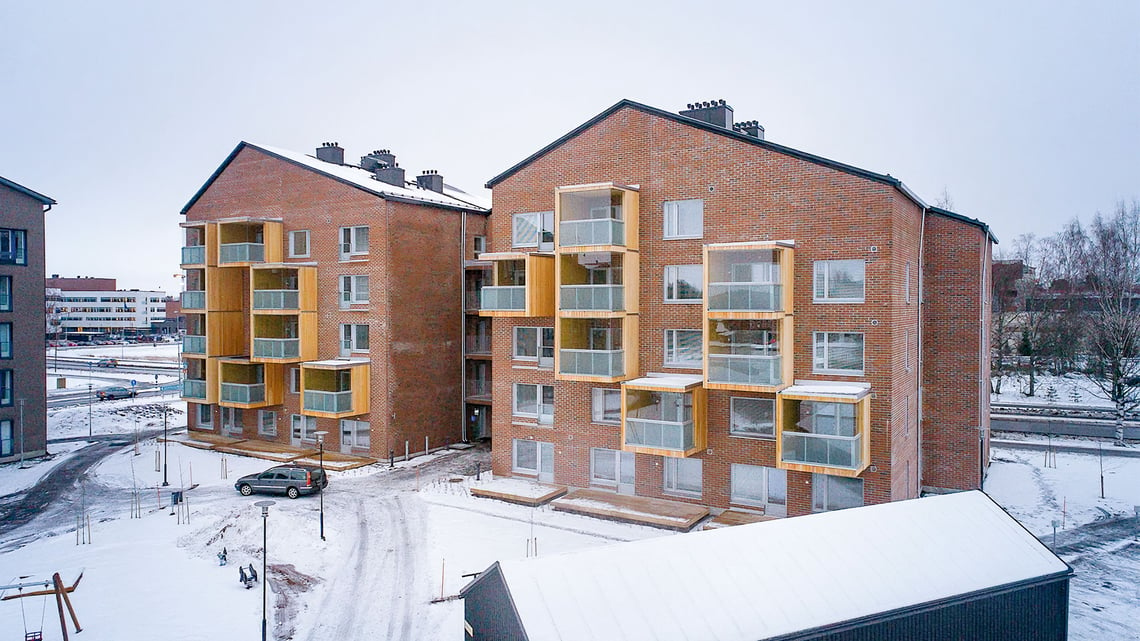
11 27 2019 | Fire protection | Fire regulations | Durability

11 27 2019 | Fire protection | Fire regulations | Durability
Fire protected wood products are subject to standards, classifications, testing methods, and requirements that even industry professionals need to read closely to understand and apply in practice. A correct understanding is important, as misunderstandings may result in solutions and wooden structures that will not provide the specified level of fire protection over the building's useful life.
Fire protection treatments can significantly improve the fire performance of wood. This protection of the wood product may be lessened substantially if the wood material is exposed to moisture or weathering
Moisture can cause the fire retardants, especially salt-based retardants, to crystallise on the surface of the wood material. The fire retardant may then be washed off the wood, which will compromise its fire performance. Flowing water, changes in the moisture content of the wood, and UV radiation may also reduce the amount of fire retardant in the treated wood material.
Considering the above, it is essential to verify the functionality of wood products and the long-term durability of their fire protection. The European Standard EN 16755 was developed for this purpose, based on Technical Specification CEN/TS 15912. The standard also makes use of research data from North America.
The tests and classes of the durability of reaction to fire performance standard EN 16755:2017 can unfortunately be confusing in some cases. The standard defines a classification system for verifying the durability of the fire protection of fire retardant-treated wood products for indoor and outdoor use. The standard defines three DRF (Durability of Reaction to Fire Performance) classes that describe the durability of fire protection:
The method of the hygroscopicity test is described in Annex A of EN 16755. It is based on the NT Build 504 and ASTM D3201-94 standards.
The test consists of submerging fire retardant-treated test specimens in water and then stabilising them in standard conditions. The moisture content is recorded once it has reached equilibrium. Each class – INT1, INT2, and EXT – has specific requirements.
The test aims to ensure that the moisture content of fire protected wood will not be significantly higher than that of untreated wood, as wood materials may become mouldy, rot, or corrode their fasteners if their moisture content constantly increases in a highly humid environment. Increased moisture content in the wood material may also affect the permanence of the fire retardant. For this reason, the standard sets class-specific maximums for the equilibrium moisture content of the test specimens.
The EXT class for fire protected wood products in exterior applications includes hygroscopic and weathering performance requirements.
Three steps are used to verify the impact of weathering on fire performance:
The durability of DRF EXT class fire protection in atmospheric conditions must satisfy the following requirements:
Products in the DRF EXT class also meet the requirements for DRF classes INT1 and INT2, but not vice versa.
| Class | Purpose of use | Initial fire class | Hygroscopic properties | Fire class after weathering |
| INT1 |
Interior dry applications |
Fire class according to the EN 13501-1 classification report supplied by the manufacturer |
- | - |
| INT2 | Interior humid applications |
Fire class according to the EN 13501-1 classification report supplied by the manufacturer |
|
- |
| EXT |
Exterior applications |
Fire class according to the EN 13501-1 classification report supplied by the manufacturer |
|
|
The general test uses Scots pine test specimens, and its classification applies to other wood species at the same retention. Tests carried out on other wood species only allow classification of the tested species.
The weathering methods accepted by the standard have major differences, and although the inclusion of multiple alternatives in the standard is partially due to the different technical properties of various fire retardants, it is also an artefact introduced by the political nature of standardisation, as industrial actors in different EU countries influence the content of standards. It is vital that the building control authorities understand the differences of the weathering methods and how they apply to buildings and construction.
For example, fire protected wood painted with ordinary paint only retains its fire class if the combination of fire retardant and paint was tested.
If the test was carried out on unpainted wood, the classification does apply to painted surfaces, but only if the topcoat does not compromise the fire class. Most ordinary exterior paints harm the fire protection, however, which is why we recommend that wood product manufacturers test their fire protected materials with different exterior paints before releasing them to the market.

Keep on track about fire safety of wood products. Our newsletter provides you with the latest ideas and solutions.

